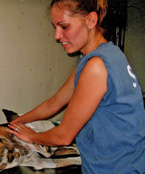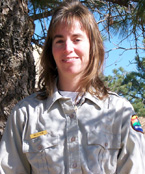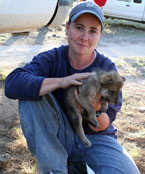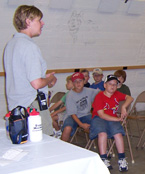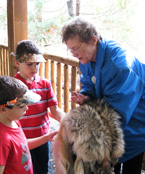 |
Before you can answer this question, you need to explore the different jobs that work with wolves. Let's hear from the people who know these jobs the best... |
|||
The Zookeeper
|
My name is Erin Czapla and I have a B.S. degree in Biology with an emphasis in Zoology from Missouri State University (formerly Southwest Missouri State University). I began my animal care career in 2002 at the Dickerson Park Zoo in Springfield, MO as an assistant zookeeper. While I worked mostly in the Asian elephant area of Dickerson Park Zoo, I also took advantage of the opportunity to work in all areas of the zoo and gained experience working with a large variety of animals including maned wolves, coyotes, and red foxes. In May of 2003, I became a swing keeper for the Miller Park Zoo in Bloomington, IL. I also gained valuable animal training experience while caring for California sea lions. In April of 2006, I joined the animal care staff at the Wild Canid Survival and Research Center. In September 2007, I was promoted to the position of lead animal care technician. |
||
Since working in a facility focused on endangered species, I found it very rewarding to take part in the mission to preserve endangered canids. I am also fascinated by the social structures and intelligence of the canids I care for. The most difficult aspect of working with these amazing animals is realizing most will never get to walk on the wild side. |
|||
The Vet
|
I am Susan Dicks, a Doctor of Veterinary Medicine (DVM) and a US Fish and Wildlife Service employee. I have been involved with the wolves through my private clinical practice for several years, but I just recently began working full-time with the Mexican Wolf Recovery Program. Having worked primarily caring for “pet animals” for more than a decade, I am thrilled with my new position and really enjoy the wildlife biology aspects of my job. My work calls for me to do a good deal of basic biology and animal care. I sometimes get to work outdoors, which I particularly enjoy. Indoor clinical dog and cat practice was great, but I was ready for a new professional and personal challenge. And I certainly found what I was looking for when I joined the Mexican Wolf Recovery program. I received my BS degree in biology in 1993 at Colorado State University in Fort Collins, Colorado. I took many undergraduate wildlife biology courses and worked many summer - jobs in wildlife. I had always planned on attending veterinary school, and studied very hard at the Colorado State University College of Veterinary Medicine for four years to learn medicine and perfect my skills as an animal surgeon. . After a grueling intern year at the largest private veterinary practice in the U.S., I entered private pet practice. I have always aspired to work with wildlife, but there are few jobs for wildlife veterinarians. Eventually, with a little serendipity, I met Maggie Dwire and some of the folks involved in Mexican Wolf Recovery. I began helping with Health Certificates and wolf check-ups, and ultimately became an official part of the program. |
||
Much of my day-to-day work involves basic animal care such as feeding and observing behavior. I also help organize wolf captures for a variety of purposes, and go “into the field” to assist with the Blue Range Wolf Recovery Area population as needed. As a DVM, I find many medical challenges working with the wolves, and regularly and have to research and evaluate medical data, and try novel ideas. Domestic dog veterinary experience is invaluable, though new clinical challenges come up all the time with the Mexican Wolves. Just like most folks, I spend time in the office on a computer entering data, reading updates and dealing with paperwork. I enjoy the job tremendously, and continually strive to understand more about wolf population dynamics and the legal and historical components of recovery so that I will make a positive contribution to the future of the Mexican Wolf. |
|||
The Curator |
My name is Holly Payne and I am the General Curator at the Living Desert Zoo and Gardens State Park in Carlsbad, NM. I have a Bachelor of Science Degree in Zoology and an Associate of Science Degree in Zoo Animal Technology. After college I was hired as a zoo keeper at the Pueblo Zoo in Pueblo, Colorado where I worked for 2 ½ years. Then I became a zoo keeper at the North Carolina Zoo in Asheboro, North Carolina where I worked for 7 ½ years. After 10 years of being a zoo keeper I wanted to advance my career and that is how I became a General Curator. As the General Curator at the I oversee the entire zoo’s animal collection and supervise 6 zoo keepers. One of the best parts of my job is walking through the zoo a few times per week to observe the animals and their exhibits. I am looking for any health or behavioral problems and any exhibit issues that may need to be addressed. There is one area in particular where I like to view our 6 male Mexican wolves and I have been able to observe many different behaviors from this area. |
||
Another job duty of mine is to attend the Mexican Wolf Species Survival Plan annual meeting which I always look forward to! |
|||
The Federal Biologist 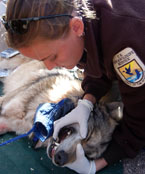 |
My name is Maggie Dwire, and I am a biologist for the US Fish and Wildlife Service. I have been working on the Mexican Wolf Recovery Program since October, 2000. My primary duties have been managing the pre-release facilities and assisting with on-the-ground recovery and reintroduction efforts. In May, 2008, I became the Assistant Recovery Coordinator for the Mexican Wolf Recovery Program and have been serving in that capacity since. The job of a caretaker or manager of a pre-release facility is unique. In addition to routine feeding and collection of road-killed carcasses and meat scraps, planning and coordinating wolf captures and transfers, and performing annual exams and veterinary checks, the caretaker is ultimately responsible for recommending wolves for reintroduction based on a comprehensive knowledge of individual wolf behavior, breeding success, and overall health and fitness. |
||
Having an in-depth knowledge of the individual wolves is also what also makes the job difficult. As biologists, we are taking part in a scientifically-based species recovery program, and recovery is about the population as a whole, not about an individual animal. We are trained to remain unbiased and emotionally unattached to the animals and the situations they encounter. Each wolf is given a number (not a name), and referred to as “it” – never as he or she. As recommendations for releases are made, the animals are fitted with radio-collars and transferred into the recovery area. We never know whether the animal will ultimately survive, perhaps reproduce and raise pups, remain within the boundary of the recovery area, or potentially become a nuisance wolf or depredate livestock. Life in the wild comes with risks, and it is difficult to follow an individual animal’s wanderings in the Blue Range Wolf Recovery Area without remembering it – idiosyncrasies and all -under our watch at the pre-release facilities. Ultimately, many of these released wolves may not survive or remain in the wild. But the ones that do are contributing to one of the most exciting recovery stories ever told under the Endangered Species Act. |
|||
The State Biologist
|
I am Ellen Heilhecker. I was Born and raised in Wisconsin. Eventually, I received a BS in Wildlife Ecology from the University of Wisconsin – Madison in 1994. After my undergrad I drifted around the U.S. working on seven different national wildlife refuges in Colorado, North Dakota (2), Virginia, Iowa, Illinois, and then back home to Wisconsin. Work ranged from volunteer positions to temporary summer jobs to limited term employment. Job duties were pretty variable depending on the refuge – lots of waterfowl surveys, two refuges I worked exclusively on piping plovers (North Dakota and Virginia) and then massasauga rattlesnakes in Wisconsin. In between the work on the NWRs – I did an internship in environmental education, teaching classes at a conservation center in northern Minnesota. Also, I had two temporary paid positions working for USDA’s National Wildlife Research Center out of Fort Collins, CO on two studies – one involving Canada geese (Minnesota), the other on white-tailed deer (Wisconsin). |
||
Through the graduate work, I tied in with the Wisconsin wolf program for five years – lots of trapping for radio collaring wolves, winter tracks surveys, radio telemetry, etc. In January 2007, I started my position with the New Mexico Department of Game and Fish Department as the state’s only Mexican wolf biologist. I am stationed in Alpine, AZ as part of the interagency field team for the Mexican wolf reintroduction project. I cover the state of NM, but mainly the Gila National Forest in Southwestern New Mexico. I have been here, relishing in the glory, ever since. |
|||
The Reproductive Physiologist 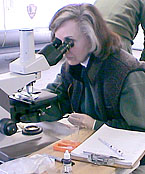 |
My name is Cheryl Asa, Ph.D. I am the Director of Research at Saint Louis Zoo and the Reproduction Advisor for the Mexican Wolf SSP. My role in the Mexican Wolf SSP is to provide expertise on captive breeding, which includes both enhancing and controlling reproduction. For example, my lab maintains a frozen bank of eggs and sperm from Mexican wolves to preserve their genes for the future, and we monitor hormone levels of females that have had trouble breeding to help identify problems. We also provide contraception when a pair is recommended not to breed, so bonded pairs can stay together. As an undergraduate at the University of Wisconsin-Madison, I had two majors: Zoology and Psychology, which combined animal physiology and behavior. I continued graduate study there in the Endocrinology/Reproductive Physiology inter-disciplinary program, which allowed me to work in Veterinary Science and the Primate Center, specializing in behavioral endocrinology. |
||
The best part of my job is that doing research means I’m always learning new things about the animals I study. The worst part is all the administrative duties needed to keep a department running. |
|||
The Environmental Educator
|
My name is Pamela Rout and I have been involved in the field of education for the last 15 years. I have been involved with wolves for 7 years as the Education Director at the Wild Canid Center and as the Red Wolf SSP Education Advisor. My previous work experience includes working as a naturalist at various natural areas and an educator/animal handler at the St. Louis Zoo. I have a BS in Forestry and a MS in Heritage Interpretation and Resource Management. It has been a lifelong dream to work with animals and I feel very fortunate to be working with wolf recovery in particular. The Wild Canid Center has been called the "cornerstone of Mexican wolf recovery" and the Center has been instrumental in bringing several species back from the brink of extinction. It has been very rewarding to be working in a facility that makes such a difference for the endangered animals we work with. |
||
As the Education Director, I am responsible for scheduling on and off-site programs. I also serve as the volunteer manager of over 40 volunteers. Our volunteers conduct most of our tours and programs as well as assist staff members with clerical and maintenance work. Other duties include program development, serving as camp director, and planning fundraising events.
My favorite aspect of the job is that I have the opportunity to assist the animal care staff in captures and medical procedures. My least favorite aspect of the job would have to be the long hours, but to me the time is worth the effort. |
|||
The Veterinary Technician
|
My name is Jenny Prom and I have been a certified veterinary technician for 13 years. All but two of those years I have worked at the Minnesota Zoo. I have a BA in geography and am an AAS as a veterinary technician. Every two years I am required to complete continuing education to keep my certification. I am very fortunate to be able to work with wildlife and exotic animals. As of 2008, the Minnesota Zoo participates in 23 AZA Species Survival Plans (SSP). The ability to get involved in these programs was a major factor for me in deciding to work for a zoo. It is so rewarding to be part of a team of people dedicated to return endangered species back to the wild. One of these projects include the Mexican gray wolf. My involvement is mostly medical in nature. I assist in wolf captures, manual restraint, immobilizations and anesthesia monitoring. |
||
My favorite wolf procedures are the reproductive research exams and of course, the puppy checks. My least favorite job is doing a stress fecal. Click here for more information about becoming a veterinary technician. |
|||
The Zoo Volunteer
|
My name is Betty Goodman and I became interested in volunteering at the Minnesota Zoo when it opened in 1978. I was a member and volunteering looked so interesting. Little did I know how interesting – and fun. I love to talk to visitors about animals, conservation and other interesting things. Using biofacts and artifacts attract visitors almost as much as the “real thing”. When volunteers are visible and accessible to the public, the visitor often comes away from their zoo visit with more respect for the animals and the environment, and more commitment to preserving our planet’s precious fauna and flora. Over the years I’ve gained more respect for the wolf, often a frightening and misunderstood animal. At the Minnesota Zoo in addition to talking to visitors about the animals, volunteers have done “wolf watch”. This means observing breeding behavior, or watching how the pups are doing, or observing behavior during introductions and reporting to the staff. |
||
Volunteers become extra eyes and ears for the staff. This is something I never expected when I started volunteering and it has become one of my favorite things to do. |
|||
